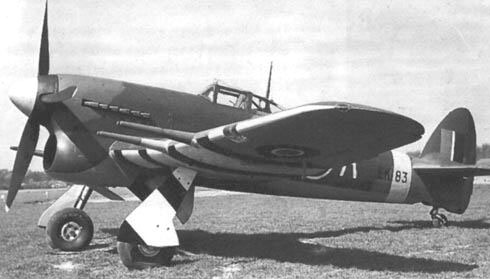BRITISH AVIATION RESOURCE CENTER > FIGHTERS > PREVIOUS PAGE

|
Type: Single Seat Fighter Bomber Origin: Hawker Models: IA and IB First Flight Tornado: October 1939 Typhoon: February 24, 1940 Production Typhoon: May 27, 1941 Final Delivery: November 1945 Number Produced: 3,330 Gloster built: 3,315 Hawker Built: 15 Engine: Typhoon IA Model: Napier Sabre I Type: 24 Cylinder Horizontal-H liquid cooled Number: One Horsepower: 2,100 hp Typhoon IB Model: Napier Sabre IIA Type: 24 Cylinder Horizontal-H liquid cooled Number: One Horsepower: 2,180 hp Dimensions: Wing span: 41 ft. 7 in. (12.67m) Length: 31 ft. 11 in. (9.73m) Height: 15 ft. 3½ in. (4.66m) Wing Surface Area: 279 ft² Weights: Empty: 8,800 lb. (3992 kg) Loaded: 13,250 lb. (6010 kg) |
Performance: Maximum Speed: 412 mph (664 km/h) Initial Climb: 3,000 ft/min (914 m/min) Service Ceiling: 35,200 ft. (10,730m) Range (with drop tanks): 980 miles (1577 km) Armament: Typhoon 1A: 12 .303 Browning machine guns in wings. Typhoon 1B: Four 20mm Hispano Cannons in outer wings. Payload: Underwing racks for Eight rockets or up to 1,000 lb. (454 kg) of bombs. Images: Image 1 - Typhoon breaking away. Image 2 - Typhoon taxiing. Image 3 - Typhoon being loaded with rockets. Image 4 - Typhoon taxiing through puddle. Image 5 - 4-View Illustration. Image 6 - First prototype (P5212). Image 7 - Second prototype (P5216). Image 8 - Typhoon IB (R7881) with Mk. IV A.I. Radar. Image 9 - Typhoon IB of No. 181 squadron. Image 10 - 4th production Typhoon IA (R7579). |
|
Comments: The Typhoons developmental life was so trouble that the entire project risked cancellations. The core of the problem were the untried powerplants that suffered from teething problems for wuite some time. Two prototypes were developed, the R-type Tornado equiped with the Vulture power plant and the N-type Typhoon equipped with the Napier Sabre. The Tornado prototype was eventually cancelled when the Vulture powerplant was abandoned. Production was delayed by the pressing need for Hurricanes and eventually the Typhoon's production was contracted to Gloster once development was complete. The Typhoon began to enter service with Nos 56 and 609 squadrons at Duxford in September of 1941. Unfortunately the type still suffered problems, the Sabre powerplant proved to be unreliable and the rear fuselage had an annoying habit of coming apart. Once again the Typhoon risked cancellation but held on long enough for the problems to be resolved and a niche to be found. In late 1941 the Typhoon gained favour by demonstrating it's ability to catch Luftwaffe Fighter-Bombers that were making hit and run nuissance raids. In 1943 the Typhoon's reputation grew as it descended on France and the Low countries and shot-up anything that moved. The type, now thoroughly developed and reliable became the premier ground attack aircraft of the RAF and proved particulayly suitable for operations from forward strips. Of the 3,330 Typhoons built, most (3,000 odd) had a bubble type canopy instead of the heavy framed canopy of the earlier type. The car style door was also deleted on these latter types. Further development of this aircraft led to the design of the Tempest. |
Gunston, Bill - The Encyclodepia of the Worlds Combat aircraft, 1976, Chartwell Books, Inc., New York
Green, William - War Planes Of The Second World War - Fighters - Vol. 2, 1961, Hanover House, New York
BRITISH AVIATION RESOURCE CENTER > FIGHTERS > PREVIOUS PAGE
